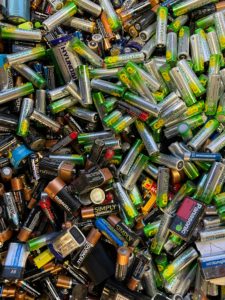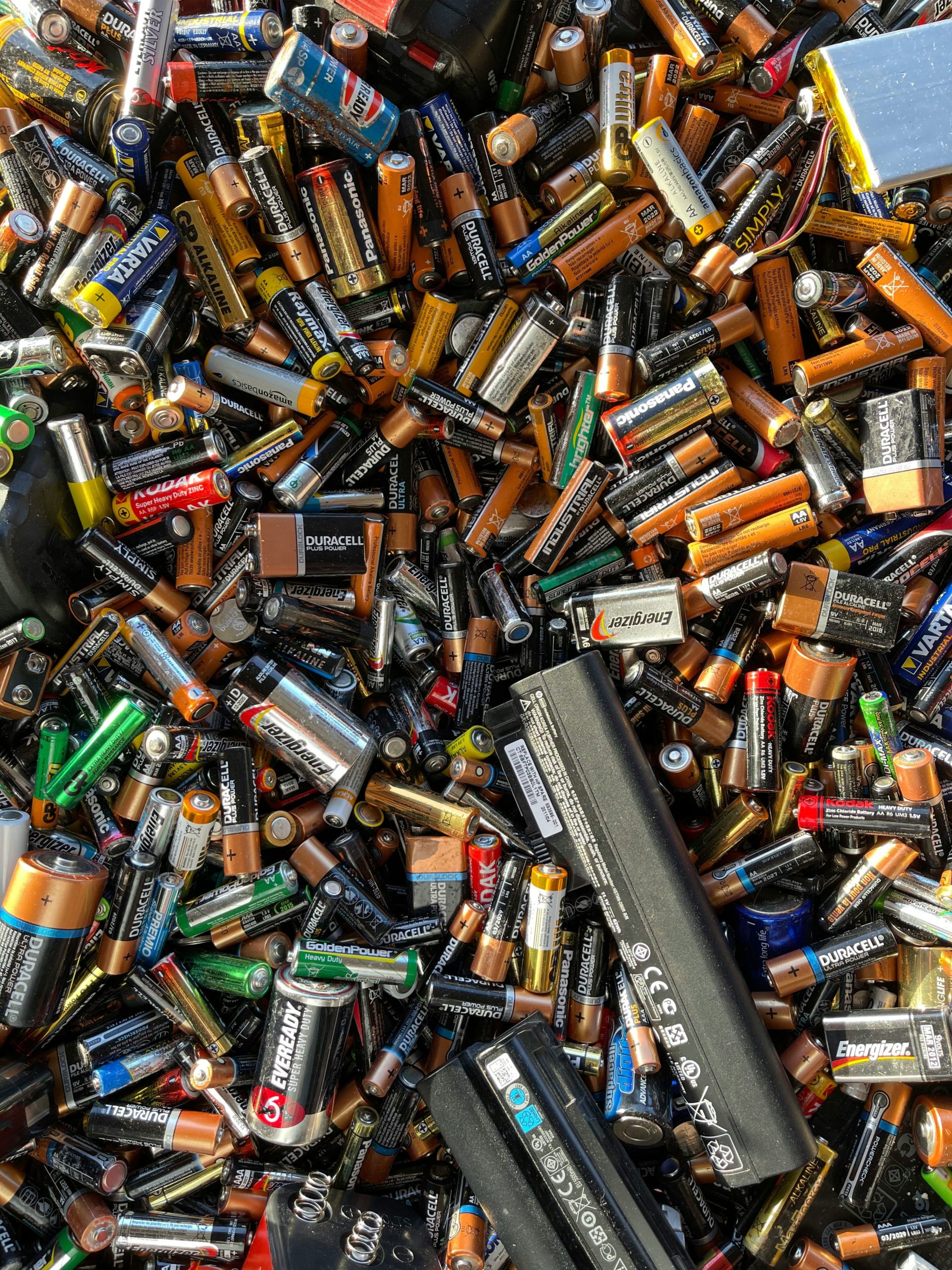Why is this important?
Small batteries, widely used for medical devices, laptops and smartphones, have a limited lifespan, whether rechargeable or not, which means they will have to be discarded.
While most used batteries are considered non-hazardous waste in the European Waste Catalogue, apart from alkaline, Nickel-Cadmium, Lead batteries and the ones containing mercury, any damaged batteries with leaking electrolyte are dangerous waste.(1) Batteries contain toxic substances like sulfuric acid, lead, cadmium, nickel and mercury, which can harm the environment and human health if improperly disposed of. Some batteries, like lithium-ion, present a risk of fire or explosion. They are difficult to recycle and can cause long-term environmental damage if thrown away improperly.
The demand for utility-scale batteries is increasing sharply: it is foreseen that they could be multiplied by 5 or 8 between 2023 and 2030.(2) In Europe, the volume of portable batteries and accumulators placed on the market increased by approximately 50% between 2009 and 2022, reaching 244 000 tonnes, while around 46% (111 000 tonnes) of used batteries were collected for recycling. (3) This means that each year in Europe, around 35 000 tonnes of portable batteries are disposed of in municipal waste.(4) In addition, the surge in the demand induces increased mining extraction, which can be mitigated by recycling and recovering primary materials.
The different kinds of batteries
1. Alkaline Batteries (disposable) using Zinc-Manganese Dioxide (ZnMnO2)
- Commonly Used In: Remote controls, toys, clocks, flashlights…
- Advantages: Widely available, affordable, long shelf life.
- Disadvantages: Can leak if left unused for a long time.
- Recycling: Separating zinc, manganese, steel, and other and reuse in road construction, steel production, fertilisers.
2. Lithium-Ion (Li-ion) Batteries (Rechargeable) (various types like NCM, NCA)
- Commonly Used In: Smartphones, laptops, portable power banks, portable medical devices (i.e. insulin pumps, oxygen concentrators, hearing aids, defibrillators…). Also used for electric cars.
- Advantages: High energy density, lightweight, rechargeable, long-lasting, low self-discharge rate.
- Disadvantages: Expensive, can degrade over time and highly flammable if overcharged/exposed to high temperatures, which makes it dangerous in air freight or on recycling sites.
- Recycling: Specialised process to separate cobalt, lithium salt, stainless steel, copper, aluminum, and plastic for reuse.
3. Nickel-Metal Hydride (NiMH) Batteries (Rechargeable) (Nickel and hydrogen)
- Commonly Used In: Digital cameras, toys, rechargeable medical devices (blood pressure monitors, thermometers, portable ECG devices…)
- Advantages: Rechargeable, high capacity, more environmentally friendly than nickel-cadmium (NiCd) batteries.
- Disadvantages: Lower energy density than lithium-ion, discharge faster when not in use.
- Recycling: Plastics removed, cells dried and processed, used to manufacture stainless steel or alloy.
4. Nickel-Cadmium (NiCd) Batteries (Rechargeable)
- Commonly Used In: Power tools, emergency lighting, and some older electronic devices. Were banned in Europe in 2009.
- Advantages: Durable, withstanding deep discharge cycles, relatively cheap.
- Disadvantages: Memory effect (capacity loss if charged when not fully discharged), contain toxic cadmium.
- Recycling: Metals like nickel, cadmium, and iron are separated and melted in high-temperature furnaces for reuse in products like new NiCd batteries.
5. Lead-Acid Batteries (Rechargeable) (Lead dioxide (PbO2) and sponge lead (Pb)).
- Commonly Used In: Larger medical equipment, such as dialysis machines, electric wheelchairs, and uninterruptible power supplies (UPS). And vehicles of course.
- Advantages: Reliable, low-cost, able to supply high surge currents for longer durations.
- Disadvantages: Heavy, low energy density, shorter lifespan, toxic (lead and sulfuric acid).
- Recycling : Only battery recycled profitably. The acid is removed, the battery melted in a furnace to recover lead. Refined lead is used in new batteries. The plastic is also recycled. Sulfuric acid is neutralised or converted in sodium sulfate. Recycling rate: 98% in high-income countries.
6. Zinc-Carbon Batteries (NOT Rechargeable)
- Commonly Used In: Flashlights, radios, and other low-power devices.
- Chemistry: Zinc and manganese dioxide.
- Advantages: Inexpensive and widely available.
- Disadvantages: Lower capacity than alkaline batteries, less efficient for high-drain devices.
- Recycled like alkaline batteries or using high-temperature metal reclamation for reuse in products such as steel, zinc roofing, and fertilisers.
7. Silver Oxide Batteries (Silver oxide (Ag2O) and zinc) (Rechargeable)
- Commonly Used In: Watches, hearing aids, small devices (calculators, glucose meters…)
- Advantages: Small size, high energy density, and stable voltage output.
- Disadvantages: Expensive and not widely available in large quantities.
8. Lithium Primary Batteries (Non-rechargeable) (lithium manganese dioxide or lithium iron disulfide)
- Commonly Used In: Cameras, medical devices (Pacemakers, hearing aids, and glucose meters).
- Advantages: High energy density, long shelf life, cope with extreme temperatures.
- Disadvantages: Expensive, need to be replaced after use.
- Recycling: Shredded and exposed to an alkaline solution to recover metals like lithium, which is converted into lithium carbonate for reuse in new batteries.
What's the solution?
As for all waste, reducing the quantity of battery waste is the first solution: prefer non-battery equipment. Then, use and store the battery in an appropriate way to extend the lifespan and reduce the replacement rate.
Once a battery has lost capacity, it can still be used for lower needs, but it is not advisable to donate it as it displaces the disposal responsibility to persons or organisation that might not have the means to discard them properly.
The only acceptable battery disposal is recycling. It reduces pollution and the recovered material reduces the greenhouse gas emissions needed for mining from 58 to 81%. (5)
Battery recycling must be done by professional, certified facilities. The first step is then to store used batteries safely, by type. Check local regulations and recognised facilities and join forces with others to mutualise stock and increase chances of negotiation. Consider transborder treatment when possible and available, taking into account it is strictly controlled.
Point of attention
-
Point of attention
Some greener, less toxic batteries are being developed such as LiFePO4 batteries (lithium iron phosphate) which use non-toxic materials and are easier to recycle than traditional lithium-ion batteries. However, they are more expensive with lower energy density (less energy for the same weight and size).
Zinc-air and saltwater batteries are also being developed, with high sustainability and low environmental impact, though not yet suitable for small devices
Such technologies produce heavy and large batteries, not favoured in today’s market, despite proven safety and longevity.
Key actions
1. Reduce battery waste
When possible, use non-powered equipment, or plug-in rather than wireless battery powered. If batteries are needed, prefer rechargeable batteries which are 90% less harmful for the environment than disposable ones (if used properly). (10) Use the battery correctly to increase the lifespan (i.e. low power mode and extend after expiry date when not at risk) and avoid exposure to high temperature (i.e. below 30°C). Store the spare batteries properly according to manufacturer specification. (11)
2. Reuse for lower performance needs
With time, cycling and heat, rechargeable batteries lose capacity, but they are still usable for electrical/ electronic devices that need a lower energy performance, like clock, radios etc. Aging batteries should not be donated to organisation or staff, as it reduces the chance that they will be properly eliminated afterwards.
3. Stored used batteries properly
Store used batteries in a climate-controlled room (below 30°C), preserved from rodents, humidity, direct sunlight, metallic objects, chemical, fuel or heat sources. Store batteries per type, avoid mixing old and new batteries or lead-acid and lithium-ion batteries. Used, ready–for–disposal batteries must be stored power-empty. (12) Avoid keeping them in plastic bags and consider specific battery safety boxes. (13)
4. Identify local regulations and facilities
Check local regulations and identify legal infrastructure certified to dispose of batteries. Recycling industries develop everywhere, keep informed about new structures, and check for quality procedures and facilities. Each type of battery requires a specific disposal process and facility.
5. Mutualise waste and organise hazardous waste campaigns
When relevant, aggregate battery waste with other organisations in order to mutualise contractualisation with certified facilities and reduce costs. Consider organising a hazardous waste elimination campaign.
6. Consider exportation
When no local facility exists and if nearby, neighbour country can and accepts to treat used batteries, then consider short-haul exportation by road, respecting the Basel Convention (must be non-hazardous, with written approval of all parties) for trans-border waste transportation. In such case, join quantities and forces with other actors.
7. Avoid encapsulation
This should be avoided and instead, evacuate rapidly used batteries from unstable contexts. Never burn or incinerate a battery (risk of explosion).
To consider
-
Potential co-benefits
- Recycling batteries reduces greenhouse gas emissions compared to new mining. (5)
- Increasing the lifespan of batteries will save money
-
Success conditions
- Staff must be informed and trained
- Storage place must be ready
- Storage place must be controlled regularly
- Battery collection must be checked regularly
-
Prerequisites & specificities
- Different type of batteries will require different type of disposal/recycling processes
-
Potential risks
- Risk of fire when stored at high temperature
- Inadequate storage and handling can harm people and the environment
- Legal risk and fees could be faced if regulations are not respected
Tools and good practices
-
Good practices to extend battery lifespan (EN)
Battery University is a free educational website offering hands-on battery information. They give tips to prolong life of all types of batteries.
Explore here -
Basel Convention Technical Guidelines for the Environmentally Sound Management of Waste Lead-Acid Batteries (EN)
Guideline on Basel Convention on transboundary hazardous waste movement, regulating Lead-Acid Batteries management.
Explore here
Further reading
-
Recycling lithium-ion batteries: A review of current status and future directions, 2024 (EN)
This study explores different battery recycling techniques and future opportunities and improvement methods.
Explore here -
How to Recycle Batteries, 2021 (EN)
Battery University is a free educational website offering hands-on battery information.
Explore here
Acknowledgments
Last updated 16th of June 2025. Inspired and freely adapted from MSF-OCB Guideline Health-related hazardous waste management within LMIC (EN).
Share your success stories, suggestions, and comments with us! contact@climateactionaccelerator.org
Featured
Garage waste management

Recycling waste in developing countries

Waste from electrical and electronic equipment

Non hazardous waste

Hazardous waste

Waste management principles

Waste

Sources
(1) Dsposal, ‘Your Dsposal’, Dsposal, 2000, Available here, (accessed 19 May 2025).
(2) IEA, ‘Batteries and Secure Energy Transitions’, International Energy Agency, 2023, Available here, (accessed 19 May 2025).
(3) Eurostat, ‘Waste statistics – recycling of batteries and accumulators’, Eurostat, 2024, Available here, (accessed 19 May 2025).
(4) Halleux , V., ‘New EU regulatory framework for batteries: Setting sustainability requirements’, European Parliament, 2024, Available here, (accessed 19 May 2025).
(5) Golden, M., ‘Recycling lithium-ion batteries delivers significant environmental benefits’, Stanford University, 2025, Available here, (accessed 19 May 2025).
(6) Dolci, G. et al., ‘Life cycle assessment of consumption choices: a comparison between disposable and rechargeable household batteries’, The International Journal of Life Cycle Assessment, Available here, (accessed 19 May 2025).
(7) Battery University, ‘BU-808: How to Prolong Lithium-based Batteries’, Battery University, 2010, Available here, (accessed 19 May 2025).
(8) Battery University, ‘BU-705: How to Recycle Batteries’, Battery University, 2021, Available here, (accessed 19 May 2025).
(9) Zarges, ‘Innovative solutions for access’, Zarges, 2024, Available here, (accessed 19 May 2025).
Credits
Cover photo: John Cameron/Unsplash
